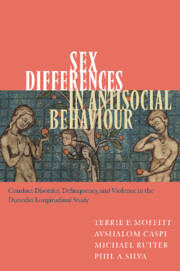 Sex Differences in Antisocial Behaviour
Sex Differences in Antisocial Behaviour Book contents
- Frontmatter
- Contents
- List of figures
- List of tables
- Preface
- Acknowledgements
- 1 Introduction
- 2 The Dunedin Multidisciplinary Health and Development Study
- 3 Sex differences in the amount of antisocial behaviour: dimensional measures
- 4 Sex differences in the prevalence of antisocial behaviour: categorical diagnostic measures
- 5 Sex differences in physical violence and sex similarities in partner abuse
- 6 Sex and the developmental stability of antisocial behaviour
- 7 Sex and the age of onset of delinquency and conduct disorder
- 8 Sex effects in risk predictors for antisocial behaviour: are males more vulnerable than females to risk factors for antisocial behaviour?
- 9 Sex effects in risk predictors for antisocial behaviour: are males exposed to more risk factors for antisocial behaviour?
- 10 Can sex differences in personality traits help to explain sex differences in antisocial behaviour?
- 11 Sex and comorbidity: are there sex differences in the co-occurrence of conduct disorder and other disorders?
- 12 Do girls who develop antisocial behaviour surmount a higher threshold of risk than their male counterparts?
- 13 Sex differences in the effects of antisocial behaviour on young adult outcomes
- 14 Sex, antisocial behaviour, and mating: mate selection and early childbearing
- 15 Evaluating the recommendation to relax the criteria for diagnosing conduct disorder in girls
- 16 Life-course persistent and adolescence-limited antisocial behaviour among males and females
- 17 Priorities for a research agenda
- References
- Index
16 - Life-course persistent and adolescence-limited antisocial behaviour among males and females
Published online by Cambridge University Press: 22 September 2009
- Frontmatter
- Contents
- List of figures
- List of tables
- Preface
- Acknowledgements
- 1 Introduction
- 2 The Dunedin Multidisciplinary Health and Development Study
- 3 Sex differences in the amount of antisocial behaviour: dimensional measures
- 4 Sex differences in the prevalence of antisocial behaviour: categorical diagnostic measures
- 5 Sex differences in physical violence and sex similarities in partner abuse
- 6 Sex and the developmental stability of antisocial behaviour
- 7 Sex and the age of onset of delinquency and conduct disorder
- 8 Sex effects in risk predictors for antisocial behaviour: are males more vulnerable than females to risk factors for antisocial behaviour?
- 9 Sex effects in risk predictors for antisocial behaviour: are males exposed to more risk factors for antisocial behaviour?
- 10 Can sex differences in personality traits help to explain sex differences in antisocial behaviour?
- 11 Sex and comorbidity: are there sex differences in the co-occurrence of conduct disorder and other disorders?
- 12 Do girls who develop antisocial behaviour surmount a higher threshold of risk than their male counterparts?
- 13 Sex differences in the effects of antisocial behaviour on young adult outcomes
- 14 Sex, antisocial behaviour, and mating: mate selection and early childbearing
- 15 Evaluating the recommendation to relax the criteria for diagnosing conduct disorder in girls
- 16 Life-course persistent and adolescence-limited antisocial behaviour among males and females
- 17 Priorities for a research agenda
- References
- Index
Summary
This chapter reports a comparison of Dunedin Study males and females who exhibited childhood-onset versus adolescent-onset antisocial behaviour. We tested whether childhood-onset delinquents had childhoods of inadequate parenting, neurocognitive problems, and temperament and behaviour problems, whereas adolescent-onset delinquents did not have these pathological backgrounds. We also queried whether females as well as males showed this differential pattern of risk, asking whether childhood-onset females had high-risk backgrounds, but adolescent-onset females did not. Finally, we ask whether Dunedin Study members on the life-course persistent antisocial path had more problem outcomes as young adults compared to those on the adolescence-limited delinquent path.
Between 1985 and 1988, when the members of the Dunedin Study grew from age 13 to age 15, we observed that many Study members who had not shown antisocial behaviour problems began to take up delinquent activities as they made the transition from childhood to adolescence. Our first descriptive report of this phenomenon contrasted those adolescent-onset delinquents with their counterparts who had been showing antisocial behaviour problems since early childhood (Moffitt, 1990b). We reported that childhood-onset delinquents were characterized by abnormal levels of individual and contextual risk factors (hyperactivity, low IQ and family adversity, among others) whereas adolescent-onset delinquents were not. The adolescent-onset delinquents' backgrounds were not inordinately healthy, but they were not pathological either; they were simply average.
- Type
- Chapter
- Information
- Sex Differences in Antisocial BehaviourConduct Disorder, Delinquency, and Violence in the Dunedin Longitudinal Study, pp. 207 - 226Publisher: Cambridge University PressPrint publication year: 2001
- 3
- Cited by


